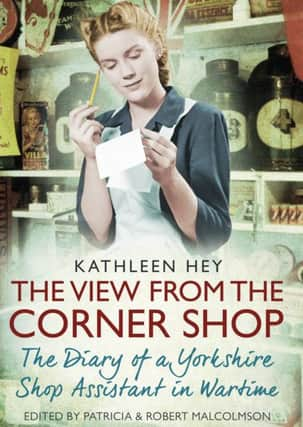Yorkshire Nostalgia: The View From the Corner Shop


Written from 1941-1946 as part of the Mass-Observation Project during the war, Kathleen Hey’s diary, edited by Robert & Patricia Malcolmson, is full of character, charm, and telling observance.
Throughout, Kathleen shines as a strong and engaging woman who refuses to give in to misery, and maintains her sense of humour under the most trying conditions.
Advertisement
Hide AdAdvertisement
Hide Ad‘Curious how “het up” everyone gets over food,’ wrote 35-year old Kathleen in her diary for September 3, 1941, two years after the outbreak of war. ‘Food really hits the tender spot.’ She was in a good position to judge, for she was an assistant in her brother-in-law’s grocery shop on the outskirts of Dewsbury. Her life was full of incidents involving daily provisions – rationing, irregular supplies, the men’s craving for cigarettes (especially scarce at the end of the war), confused and irate customers and the grievances they gave voice to.
These customers were anything but posh. They were all, she said, ‘working class and most of them wear shawls on their heads and do not use soap too often but they are not as poor as they seem and do not mind what they spend on food if they can get it.’ They were also her neighbours, for she lived over the shop, with her mother and her sister and her husband.
This remarkable diary, written for the social research organisation Mass Observation, gives a vivid picture of wartime living and social relations in a gritty industrial city. We read of fire-watching, evacuees from London, Belgian refugees, striking miners, women conscripted for national service, fatal accidents, entertainment on the wireless, Holidays at home, restless youth, and much more. The diary is a sparkling expression of history from below – life as experienced by labourers, housewives, and shopkeepers.
There are also surprises. When the Sadler’s Wells Opera arrived in this proletarian community in January 1944, the theatre was packed. ‘I know one bus conductress who was going three times and another girl who is going every night. One of our customers, definitely not a highbrow, went to see The Barber of Seville on Monday and she was so charmed she is going to see Madame Butterfly.
Advertisement
Hide AdAdvertisement
Hide AdShe said the gallery was full of young girls and children but you could have heard a pin drop. Feeding the imagination was a vital antidote to the grind and dreariness of wartime existence.
Kathleen’s diary is rich in such observations. She also had a personal life, wavering political opinions, wide-ranging cultural tastes, and hopes for the future. A single woman, she regretted being cooped up in a household of people with whom she had little in common. She occasionally wrote of her desire for like-minded friends. And she often wrote wittily about the prejudices and quirks – not to mention cunning – of those she met and sometimes argued with.
It is a lively and colourful portrait by an astute observer.
The View from the Corner Shop by Kathleen Hey, edited by Robert & Patricia Malcolmson. Published by Simon & Schuster on 21st April, £7.99.